
The small Chapel of Sao Pedro de Balsemao, is situated in the civil parish of Sé, municipality of Lamego in the northern region of Portugal. It was a Visigothic sanctuary dating back to the 7th century, although it has Baroque elements, in particular, in the South Gate and the western facade, which adjoins a later residential building.

Labruja is a civil parish in the municipality of Ponte de Lima in northern Portugal. The population in 2011 was 439, in an area of 14.56 km².
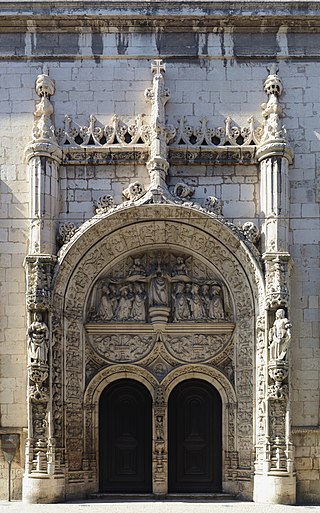
The Church of Nossa Senhora da Conceição is a church in the civil parish of Madalena, in the municipality of Lisbon.

The Abbey of St. Batholomew, more simply known as the Abbey of Arouca, was a Cistercian monastery of women dating from the 10th century. It is located in Arouca, now in the Porto metropolitan area of Portugal. For much of its existence, it was one of the most influential religious centers in that region of the country.

The Church of São Lourenço is a Church in the civil parish of Almancil, in the municipality of Loulé in the Portuguese Algarve.
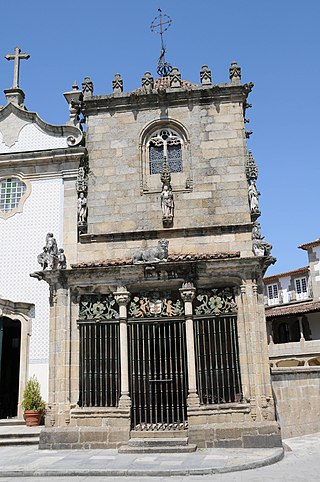
The Chapel of the Coimbras is a Manueline chapel located in the civil parish of São João do Souto, in the municipality of Braga. It has been classified as a National Monument since 1910.
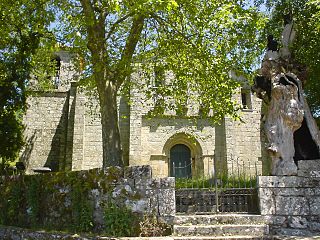
The Church of Santo André is a Romanesque and Baroque era Portuguese religious building located in the civil parish of Fiães, municipality of Melgaço, in the northern Portuguese district of Viana do Castelo.

The Diogo Bernardes Theatre is a theatre in the civil parish of Arca e Ponte de Lima, in the municipality of Ponte de Lima, in the Portuguese district of Viana do Castelo.
The Church of the Miserícordia de Valadares, or Church of Mercy/Charity of Valadares, is a 17th–18th-century Portuguese church located in the civil parish of Valadares, municipality of Monção in continental Portugal. The church was classified as Property of Public Interest in 1961.

The Church of São Miguel do Castelo is a medieval church in the civil parish of Oliveira do Castelo, municipality of Guimarães, in the northern district of Braga of Portugal. The church is emblematically linked to the foundation of the Portuguese Kingdom. Legend suggests that it was the sight of the baptism of the young Afonso Henriques. These claims are contradictory, since the date of the church's founding has been suggested to be during the reign of Afonso II of Portugal.

The Sanctuary of Our Lady of Lapa and Residence of the Society of Jesus is a Christian sanctuary in the civil parish of Quintela, municipality of Sernancelhe of northern Portugal. The historical residence of the Society of Jesus, this site was transformed to support pilgrims to the site, and is marked by a chapel delineated by Corinthian columns, supporting plinths surmounted by simple frieze and cornice. The interior was decorated in azulejo tile of polychromatic vegetal design, with triumphal arch dividing the sanctuary from the college, identifiable by the large granite rock in its interior, where legend says the image of the Virgin Mary was first discovered. In this space is the oratory of Senhora das Dores with its nativity by António Ferreira. In the junction between presbytery and sacristy is the double-arched belfry. Also remarkable and unique for this site, and other buildings owned by the Society of Jesus, is the walkway that connects the residences of the complex with the church.
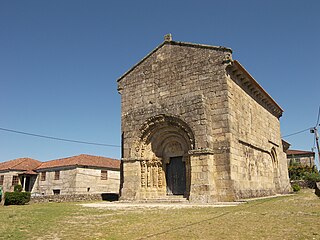
The Church of São Salvador is a Romanesque era Portuguese religious building located in the civil parish of Bravães, municipality of Ponte da Barca, in the northern Portuguese district of Viana do Castelo.

The Convent of Caloura is a Portuguese 16th-century convent located in the civil parish of Água de Pau, in the municipality of Lagoa, on the island of São Miguel in the archipelago of the Azores.
The Sanctuary of Nossa Senhora do Engaranho is a church in the civil parish of Calvão e Soutelinho da Raia, in the municipality of Chaves, in the Portuguese Norte Vila Real.

The Church of Nossa Senhora do Bom Despacho is the parochial church of the civil parish of Almagreira, located in the municipality of Vila do Porto, Portuguese archipelago of the Azores. It is a church of masonry, plastered and painted, constructed with decorative pilasters, friezes and cornices, molds and corner pinnacles, with a carved retable and tile covering.
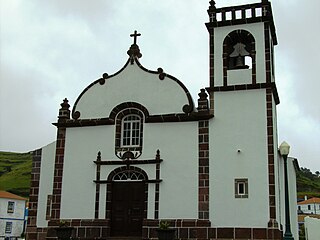
The Church of Santa Bárbara is a Roman Catholic church in the civil parish of Santa Bárbara, municipality of Vila do Porto, in the archipelago of the Azores. Located in the valley of the same name, the parochial church of Santa Bárbara was constructed sometime in the early 15th century and served the impoverished parish throughout its history, supported by personal donations and community assistance.
The Convent of Carmo is a former-convent situated in the civil parish of Matriz, municipality of Horta in the Portuguese archipelago of the Azores. For several centuries it was one of the several convents that dotted the urban area of the island of Faial, but was damaged during several earthquakes. After the expulsion of the religious orders the convent began a slow decline, and was eventually expropriated by the Portuguese Armed Forces as an administrative post and garrison.

The Palace of Calheiros is a 17th-century Baroque manorhouse and tourist guesthouse located in the civil parish of Calheiros, municipality of Ponte de Lima, in the northern region of Portugal.
The Church of Santíssima Trindade is an 18th-century church located in the civil parish of Fazenda in the municipality of Lajes das Flores, in the Portuguese island of Flores, in the archipelago of the Azores.

The Church of Nossa Senhora da Conceição is an 18th-century church located in the civil parish of Santa Cruz in the municipality of Santa Cruz das Flores, in the Portuguese island of Flores, in the archipelago of the Azores.




















